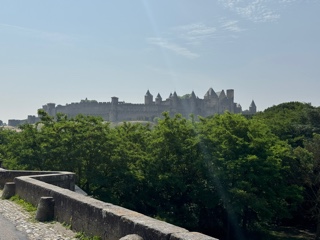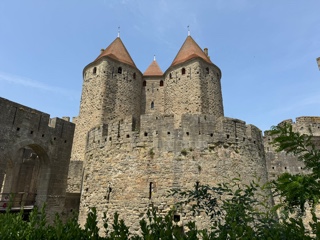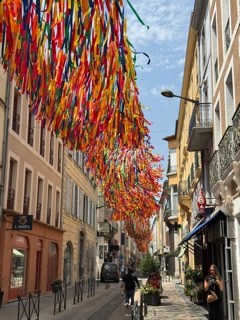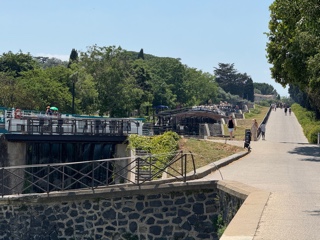The Languedoc

Casamara
John & Susan Simpson
Thu 26 Jun 2025 15:47
Continuing eastwards around the globe, back towards Casamara in her Malaysian hideout, we flew from Gatwick to Montpellier in southern France. During an earlier jaunt along the French Mediterranean coast by train, we’d had to bypass the area around Montpellier but had liked what we’d seen of the area enough to want to come back for another look. As we’re heading to Greece next it seems appropriate that Greece has a significant historical connection to this area. There’s archaeological evidence of Greek settlements along this section of France’s mediterranean coast dating back at least 2,500 years. We based ourselves in Montpellier but used the excellent trains, trams and occasional car hire to go further afield. We were delighted to get to the Perpignan area to visit Janette and Ben, formerly of the yacht ‘Liberty'. We sailed in company with them from St Lucia in the Caribbean to Tahiti in French Polynesia, where they decided to sell Liberty and move on to other adventures. It was lovely to see them and to hear what they’d been up to since we last met. They had also spent time in Australia, New Zealand, South Korea and Japan so we spent many hours swapping stories of escapades in similar places! We love catching up with our sailing friends scattered across the world. From Perpignan we spent a few nights in Carcassonne. I’d long wanted to visit Carcassonne since reading ‘Labyrinth' by Kate Mosse years ago. The descriptions of the medieval city had really captured my imagination and it didn’t disappoint. We stayed in the lower town, in itself an attractive and historic place, but it was the upper town - the medieval part - that was the highlight. Perched on a hill with its high walls and 52 towers, it looks like a fairytale castle. There’s too much history associated with Carcassonne to summarise here, except to say that the city is particularly famous for its role in the Crusades in around 1210 when it was a stronghold of the Cathars. It was easy to see how the fortifications would have kept invaders out. We could easily have spent a week here!  Medieval Carcassonne from the old bridge in the lower town  City walls close up  The lower town streets were hung with rainbow coloured streamers, accentuating the breeze and giving some dappled shade From Carcassonne we drove back towards Montpellier via Beziers through the Corbieres wine region. We have the Greeks to thank for the lovely wine in this area. They introduced viticulture to southern France when they arrived 2,500 years ago and today the vines stretch as far as the eye can see. We became very partial to a refreshing cold glass of crisp Rose wine after a hot day’s exploring. Did I say a glass? It was very moreish!! We hadn’t realised that the Canal du Midi finds its way into the Mediterranean Sea in this area, nor even how old the Canal is. It was built in the reign of Louis XIV in the late 17th century to connect the Atlantic Ocean with the Mediterranean, starting in Toulouse and reaching the Mediterranean at Sete. It’s part of the extensive French canal network which stretches from the English Channel to the Mediterranean. We had a VERY hot walk alongside a part of the canal path to see ‘Les Ecluses de Fonseranes’. This staircase of locks (originally 9 lock basins) raise and lower boats by a height of 21.5 metres. We also walked over the Aqueduct over the River Orb which, at 240 metres, is the longest on the Canal du Midi. Fortunately there was also a canal-side cafe where we were able to cool ourselves down with a long cold drink - not Rose wine this time!  The 9 locks Beziers from the Orb Aqueduct Montpellier itself has an interesting history. The Via Domitia, the Roman road that connected Rome with Cadiz ran close to Montpellier. The city later became part of the Kingdom of Majorca under James I of Aragon before being sold to France in 1349. My Kingston Hospital colleagues might be interested to know that Montpellier’s medical school is the oldest continuously operating medical school in the world, having been in existence since 1220. The area around the medical school and the adjoining Montpellier Cathedral was one of our favourite places to sit to watch the world go by. Not to mention, the location of our favourite lunchtime Creperie. It’s probably a good job that our time in France has come to end as our waistlines are rapidly expanding!  Carcassonne Medical School  Montpellier Cathedral and the winding streets around it From Montpellier we fly to Greece to visit some of the places associated with the voyages of St Paul. |